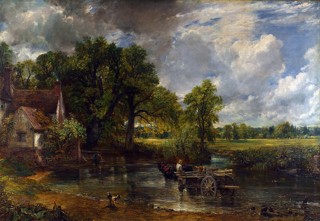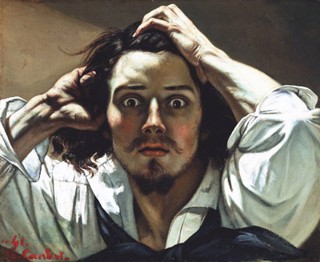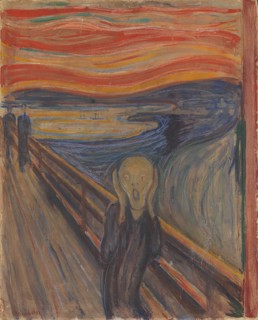A Guide to Romanticism, Realism, and Expressionism in Art
Art will always be interesting. Whether it’s to look at, study, or simply admire and be surrounded by it, art plays a very important role in the way our culture is shaped and defined. Art is expressed and interpreted by different people in different ways; whether it be a student studying a degree, a mother of four walking past a gallery on her way to work, or an emerging artist creating a new piece in their studio - the experience of art is different for all.
Because art can range widely and vary so much between different styles and mediums, it’s always good to know what art forms are available and how they differ from other styles. Throughout history there have been numerous art movements and styles, all expressed differently by the artists who used them as inspiration for their works. This article will look at the three movements of romanticism, realism, and expressionism in art.
Romanticism
Dating around the early 19th century, romanticism aimed to steer away from its previous classicism styles. Forming part libertarian and egalitarian ideals of the French Revolution, romanticism aimed to provide art that had a glimpse of the ideal. This form of art looked at ways that it could represent and emphasise the emotional, spiritual, and unattainable ideal of forms.
Artworks of romanticism would often portray a scene or person, adding features to the image to make it appear closer to the notion of perfection. Images painted in this style will often be close to realism, but with colours distorted to make the painting more beautiful. For example, a glimmering sunset portraying a picturesque scene may be painted with extra golden tones and be brighter in its final form than what would have appeared in reality. This style focused quite a bit of emphasis on the senses and emotions over reason and intellect. Famous painters of romanticism often worked to provide an image that represented a feeling towards the Earth and life, rather than the exact way it would appear to the naked human eye.
Popular romantic artists and artworks
This particular art style was explored by many artists. Over the years, their art grew in popularity and to this day romanticism still draws a crowd at major art galleries around the world. Some of the most famous works and artists of romanticism include:
John Constable "The Hay Wain" (1821)
The Hay Wain (1821) - John Constable
Depicting an image of water, horse and cart, and building along the water’s edge, this piece is one of great importance to this style of art. Although it appears to be a simple enough painting, the style, shape, and colours of the clouds and sky amongst the almost glowing yellowing of the trees shows the true style of romanticism.
Gothic Cathedral by the Water (1813) - Karl Friedrich Schinkel
This painting often takes people’s breath away. Showing a backlit cathedral along the edge of the water, with workers on the opposite side of the water going about their daily business, Schinkel has managed to perfectly portray how the sun can make even the dark side of a building look attractive and intriguing. Added to this the way the clouds are formed and shaped in the sky with ease and sense of movement, this piece truly stands out amongst some of the most famous romanticism pieces of all time.
Memory of Mortefontaine (1864) - Jean-Baptiste Carot
One of the main attempts of Carot in this painting was to reflect the image as though it was a blurry photograph. He attempted this rather well, and although still a beautiful scene, the image has been romanticised due to the speckles of light reflecting across the image, which almost appear to be fairytale-like. The light reflection on the water creates a pleasant scene. Although the painting is mostly realist, the fact that other paint effects have been incorporated into the image makes this style a work of romanticism. Being one of the most popular pieces of romantic art in the world, it’s not hard to see why.
Colin Parker’s oil based paintings turn the outbacks striking natural scenery into an elevated image of romantic beauty with his use of bright colours. Romanticism blurred with Australian contemporary art, we’ve never seen the Outback sky look so colourful.
Realism
Just as the name suggests, realism is art that depicts the real authenticity of a subject matter. Idealism is revoked in this style, and the focus is more on the real and actual and not the artist’s imagined reality. Realism dates back as early as the 1400s and many historical pieces are realist in nature. Historical paintings, portraits, and landscapes of early years were all painted with realistic principles, however the term wasn’t used until the 1840s by French novelist, Champfleury.
Artists working within the realism form were free to discover and portray real scenes of landscapes and people. Many artists of the time ventured to find scenes of landscapes and depict them through their paintings to offer viewers a chance to see what the place of choice really looked like. Painting human subjects aimed to depict a person’s true looks and show the ‘real them’. Some of the most favoured subjects by realist artists were scenes of rural and urban working life, street life, cafes, nightclubs, the human form, and nudity. During the peak era of realism - unsurprisingly - many upper and middle class patrons were shocked by the subject matter of some of the artists. In France and Victorian art of England, therefore, realism was not completely embraced.
Popular realist artists and artworks
With an abundance of realist artists in the world, it’s hard to narrow down a selection of some of the most popular. Here are just a few:
Self Portrait (The Desperate Man) (1843-45) - Gustave Courbet
As the title explains, this self portrait by Courbet shows a desperate man, painted as close to reality as possible. This work excels in realism, and many have commented on how you can almost feel the desperation in the eyes of Courbet in this painting. Courbet was dedicated to painting only what he saw, and completely rejected the style of romanticism that existed prior to realism’s popularity. Courbet was also recognised for his other artworks such as The Wave, The Origin of the World (L’Origine du Monde), and The Source.
● The Doctor (1891) - Luke Fildes
This painting was originally commissioned by Sir Henry Tate in 1890, and Fildes was allowed to paint anything of his own accord. Fildes decided to depict a harrowing scene of the time his first son had passed away. The image shows a doctor overlooking the child laid across two dining chairs, while Fildes and his wife overlook in the background with sadness. Although a dark image and quite disheartening, this painting is a true reflection of realism.
German born Australian artist Falk Kautzner represents the Australian landscape with such realism you’d think they were works of photography. His paintings portray the Australian beaches with striking realism so successful you can almost smell the seawater.
Expressionism
Edvard Munch, 1893, The Scream, oil, tempera and pastel on cardboard, 91 x 73 cm, National Gallery of Norway
Expressionism is generally considered to have originated in Northern Europe, in particular Germany. Expressionist artworks first began to appear across Germany and were thought to have been a reaction to the ever increasing unattachment to the real world by society, and the loss of authenticity and spirituality by the human race. From Germany, this style of art began to increase and spread throughout Europe and the rest of the world.
Expressionism saw artists expressing their work from within themselves, and wasn’t limited to the realist art principles of the external. The way this style of art was assessed generally came down to how the artist was successfully able to depict their own feelings within the artwork as opposed to the assessment of the composition. This style of art will often show large swirls, swaying, and exaggerated brushstrokes. These strokes were intended to represent the swirling turmoil of society, and the human race and its reaction to the modern world.
Popular expressionist artists and artworks
● The Scream (1893) - Edvard Munch
Perhaps one of the most famous artworks of all time, The Scream depicts an image of Munch walking across a bridge overlooking Oslo. He stated that the sky had turned a bright red, and his fear and anxiety of his surroundings and the changes happening around him were the main inspiration for this artwork.
The Starry Night (1889) - Vincent Van Gogh
Not all expressionist artworks depict anger, fear, and anxiety. The emotions can range right through to intensity, passion, and love. The Starry Night by Van Gogh shows large and over exaggerated swirls of colour, ranging from beautiful yellows to dark blue hues. This painting shows Van Gogh’s inner emotions spread out across a city landscape.



